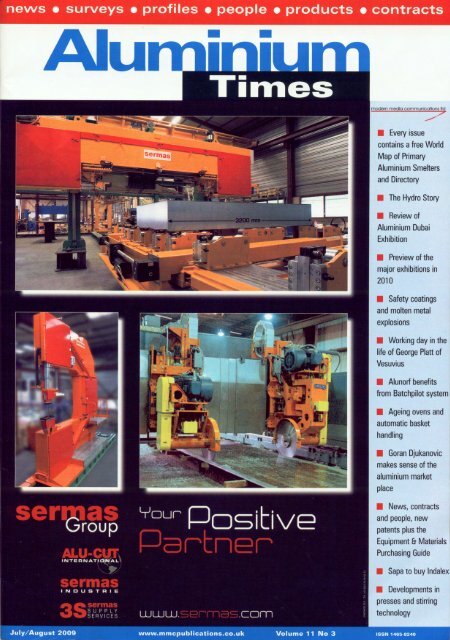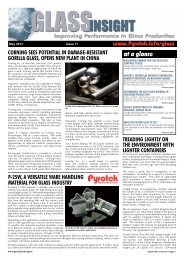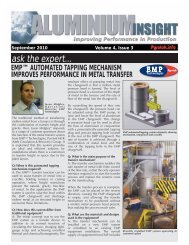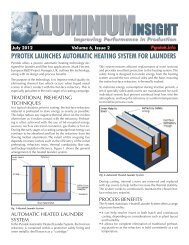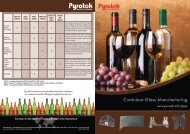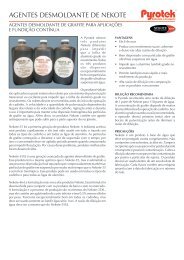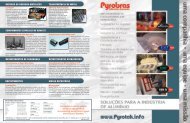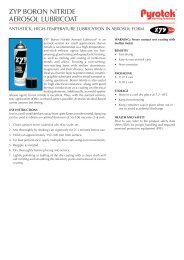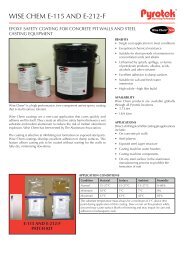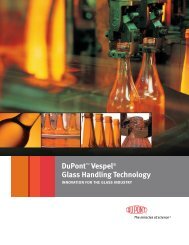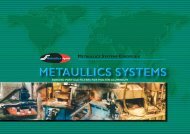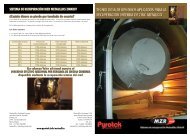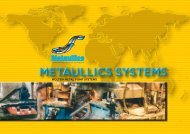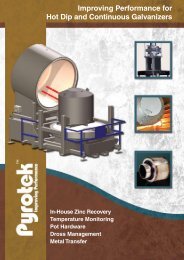Safety Coatings Reduce Risk of Molten Aluminium ... - Pyrotek
Safety Coatings Reduce Risk of Molten Aluminium ... - Pyrotek
Safety Coatings Reduce Risk of Molten Aluminium ... - Pyrotek
Create successful ePaper yourself
Turn your PDF publications into a flip-book with our unique Google optimized e-Paper software.
<strong>Molten</strong> Metal Explosions<br />
<strong>Safety</strong> coatings reduce risk <strong>of</strong><br />
molten aluminium explosions<br />
Working under demanding conditions with hazardous materials and processes certainly constitutes severe HSE risks. For<br />
example, incidents <strong>of</strong> molten metal explosions in production plants can be disastrous in terms <strong>of</strong> employees’ lives and<br />
also in relation to plant, property, and environmental and collateral damage. Here, Alex W. Lowery, General Manager,<br />
Wise Chem LLC, examines the background and causes <strong>of</strong> such incidents, along with certain preventive measures<br />
centred on special safety coating products, which are used effectively in production practice.<br />
1: The Force 3 explosion which took place on August 20, 2007 at Binzhou Weiqiao Aluminum Company, in The People’s Republic<br />
<strong>of</strong> China, when 16 employees were killed, and 64 injured<br />
The first molten metal explosion to be reported occurred<br />
in an aluminium casthouse over 60 years ago. Tests were<br />
carried out soon afterwards to determine the actual circumstances<br />
and root cause <strong>of</strong> the incident. It was concluded<br />
that the explosion had been due to a bleed-out<br />
during a direct chill casting operation.<br />
Subsequently, an investigation was conducted to<br />
determine if any preventive measures could be instituted<br />
to prevent such explosions. Results showed that<br />
certain organic coatings, such as Wise Chem E-212-<br />
F, were effective in preventing molten metal explosions,<br />
whereas some other organic coatings, in fact,<br />
could even initiate and promote these incidents.<br />
Fifteen years ago, the U.S. Department <strong>of</strong> Energy<br />
together with the Aluminum Association, repeated the<br />
procedures to investigate the root cause <strong>of</strong> the molten<br />
metal explosions. Testing revealed that an initiator or<br />
trigger had to be involved for a molten metal explosion<br />
to occur. The tests also identified three additional<br />
coatings that could afford protection against such<br />
explosions.<br />
Whenever two liquids, with widely different temperatures,<br />
come into contact, an explosion can result.<br />
This is purely a physical phenomenon, but with aluminium<br />
there is an additional concern because it is<br />
a very reactive element that has a strong chemical<br />
attraction for oxygen, as evidenced in its naturallyoccurring<br />
compounds. Just as a large an amount <strong>of</strong><br />
energy is required in reduction cell electrolysis to break<br />
down the aluminium-oxygen bonds <strong>of</strong> its oxide form<br />
to produce metallic aluminium. This energy is released<br />
dramatically if the metal is able to recombine with<br />
the oxygen from either water or air. The energy<br />
released when 0.5 kg <strong>of</strong> aluminium fully reacts with<br />
oxygen, according to the reaction equation set out<br />
below, is equivalent to detonating 1.4 kg <strong>of</strong> trinitrotoluene<br />
(TNT).<br />
2Al+3H2O = Al2O3+H2 + Energy<br />
Explosion force defined<br />
There are three distinctly-different types <strong>of</strong> explosions<br />
that can occur when molten aluminium comes<br />
in contact with water. The Aluminum Association has<br />
administered a molten metal incident reporting system<br />
for the past 20 years and this defines the different<br />
levels <strong>of</strong> explosion as Force 1, Force 2, and Force<br />
3, characterised as follows:<br />
• Force 1 explosions, also referred to as “steam explosions”<br />
or “pops”, occur when molten metal traps<br />
water, which is quickly converted to steam. These<br />
explosions are characterised by metal thrown a short<br />
distance, usually up to about 4.5 m and <strong>of</strong>ten in<br />
amounts less than 4.5 kg, with minimal or no property<br />
damage.<br />
• Force 2 explosions are violent steam incidents. As<br />
with a Force 1 explosion, water is trapped and turns<br />
to steam instantaneously. But in this case, the water<br />
is trapped by the molten metal and pressure builds<br />
up to the point where considerably more metal is<br />
thrown a great distance, between 4.5-6 m, <strong>of</strong>ten up<br />
to the ro<strong>of</strong> <strong>of</strong> the plant. There is also possibly some<br />
accompanying equipment damage.<br />
• Force 3 explosions are catastrophic events arising<br />
from reaction <strong>of</strong> molten metal with oxygen from<br />
water, air or both. These incidents are characterised<br />
by considerable property damage and metal being<br />
ejected more than 15 m. Often, the molten metal<br />
disappears completely and what remains is a white<br />
powder – aluminium oxide. An example <strong>of</strong> the disastrous<br />
consequences <strong>of</strong> a Force 3 explosion is<br />
shown in Fig 1 and Fig 2.<br />
2: A more general view <strong>of</strong> the explosion at Binzhou Weiqiao<br />
Aluminum Company<br />
3: The Jumbo E 115 repair kit<br />
Targeted investigations<br />
For more than 60 years, studies <strong>of</strong> molten aluminium-water<br />
explosions have been conducted within<br />
companies’ in-house laboratories, at government establishments<br />
and at independent facilities, to understand<br />
all aspects <strong>of</strong> these types <strong>of</strong> explosions. Some <strong>of</strong> the<br />
earliest tests were performed by George Long in the<br />
late1950’s at Alcoa’s Research Laboratories in New<br />
Kensington, Pennsylvania. Long pioneered experimental<br />
methods for investigating aluminium-water<br />
and steam explosions. In his experiments, various<br />
<strong>Aluminium</strong> Times July/August 2009 www.mmcpublications.co.uk 61<br />
Feature
Feature<br />
<strong>Molten</strong> Metal Explosions<br />
4: Applying the coating E-212-F to aluminium<br />
quantities <strong>of</strong> molten aluminium were poured over submerged<br />
surfaces, coated or uncoated and the elimination<br />
or occurrence <strong>of</strong> explosions was determined<br />
empirically. Much <strong>of</strong> Long’s research knowledge is<br />
still relevant today, and forms the basis for the current<br />
regimes for preventing molten metal explosions<br />
in casting pits.<br />
Long determined that certain surfaces, such as rusted<br />
steel, gypsum and lime, promoted violent explosions,<br />
whilst other surfaces, such as polished steel and<br />
aluminium and those with organic coatings, were relatively<br />
resistant to spontaneous explosions. Subsequent<br />
studies found that an organic coating, Tarset Standard<br />
(TS), was the most practical medium available at that<br />
time to prevent molten metal explosions. Unfortunately,<br />
over time, Tarset Standard was shown not to<br />
adhere well to wet concrete walls <strong>of</strong> casting pits. In<br />
response, Wise Chem E-212-F was introduced to the<br />
market, because <strong>of</strong> its effective adherence in these situations.<br />
Subsequent testing showed that Wise Chem<br />
E-212-F <strong>of</strong>fered the necessary protection required to<br />
prevent molten metal explosions.<br />
Due to environmental regulations, the manufacturer<br />
subsequently discontinued the production <strong>of</strong> Tarset<br />
Standard and so the aluminium industry was left with<br />
just one available organic coating that had been thoroughly<br />
tested — Wise Chem E-212-F. The Aluminum<br />
Association, in conjunction with aluminium companies<br />
and coating manufacturers, sponsored a programme<br />
<strong>of</strong> testing at Alcoa’s Technical Center. The<br />
objective was not to find a replacement for Wise Chem<br />
E-212-F, but to identify additional environmentallyfriendly<br />
coatings for application in the aluminium<br />
industry.<br />
Two explosion test methods were performed for each<br />
additional new coating – a standard explosion test and<br />
a shock impact test.<br />
The standard explosion test was performed utilising<br />
an 0.028 cu m open steel box and the prospective<br />
coatings were applied to the interior surface. The opentopped<br />
steel container was filled with approximately<br />
15 cm <strong>of</strong> water and a clay/graphite crucible, containing<br />
23 kg <strong>of</strong> molten aluminium at 760°C, was positioned<br />
40 cm above the open container. Metal was<br />
released through an 8 cm diameter opening at the<br />
bottom <strong>of</strong> the crucible. One particular coating initially<br />
passed the test because it prevented an explosion, but<br />
then failed when it combusted and produced sizable<br />
flames after a few seconds in contact with the molten<br />
aluminium.<br />
In the past, some molten metal-water explosions that<br />
were investigated were found to have resulted from<br />
a mechanical shock prior to the explosion. The<br />
researchers added a swinging hammer that would provide<br />
extra force on impact with the steel container, in<br />
order to further investigate the effect this would have<br />
on risks <strong>of</strong> explosion.<br />
<strong>Safety</strong> coatings pass the test<br />
Four coatings passed the standard explosion test:<br />
Wise Chem E-212-F; Wise Chem E-115; Multigard<br />
955CP, and Intertuff 132.<br />
Larger explosions, and some instances, multiple<br />
incidents, were generated when the shock impact test<br />
was performed on bare substrates. Each <strong>of</strong> the three<br />
new coatings that passed the standard explosion test<br />
also passed the shock impact test. Each coating was<br />
tested only once due to budget constraints. Plant accidents<br />
in the past have demonstrated that the effect <strong>of</strong><br />
a protective coating can be overridden by a sufficiently<br />
Wise Chem<br />
E-115 and<br />
E-212-F<br />
Wise Chem is an amine epoxy material that provides<br />
a high-performance, two-component, multipurpose<br />
coating, which is truly surface-tolerant.<br />
Wise Chem coatings require only a single-coat<br />
application that cures quickly and adheres well to<br />
itself. Tested by the Aluminum Association, they<br />
are proven to create an effective safety barrier<br />
between a wet substrate and molten aluminium<br />
to reduce the risk <strong>of</strong> molten aluminium explosions.<br />
The coating is effective in inhibiting rust formation<br />
on exposed steel components and also<br />
develops excellent adhesion to damp surfaces. This<br />
allows casting pits to be coated without waiting<br />
for the walls to fully dry, which also minimises<br />
process down time.<br />
Product Advantages:<br />
• Single-coat application in most conditions<br />
• Exceptional chemical resistance<br />
• Suitable for short periods <strong>of</strong> immersion in concentrated<br />
acids and alkalis<br />
• Unharmed by splash, spillage, or fumes <strong>of</strong> petroleum<br />
products, alkalis, acids, alcohols and other<br />
solvents<br />
• Excellent adhesion to damp surfaces<br />
• Suitable for both salt and fresh water immersion<br />
• High solids and high film build.<br />
Wise Chem E-115 and E-212-F are also both<br />
available in the form <strong>of</strong> Patch Kits, as 1-litre tubs,<br />
designed especially for smaller-scale jobs and<br />
repairs. The contents, as supplied to customers,<br />
are pre-measured and ready to mix in the correct<br />
proportions.<br />
Wise Chem products are supplied by <strong>Pyrotek</strong><br />
Inc. under licence from the manufacturer.<br />
Reader Reply No.120A<br />
large shock during the casting process.<br />
Further studies have shown that a bare exposed area<br />
as small as 100 sq cm <strong>of</strong> substrate can initiate an explosion.<br />
Consequently, the maintenance <strong>of</strong> the existing<br />
coating surfaces is an integral part <strong>of</strong> preventing molten<br />
aluminium-water incidents. With feedback and input<br />
from the aluminium industry, certain coating manufacturers<br />
developed repair kit versions <strong>of</strong> their products,<br />
Fig 3, to enable easy maintenance and repair <strong>of</strong><br />
the existing coating surfaces to be carried out.<br />
For some unknown reason, certain aluminium companies<br />
still do not use any protective coatings on steel<br />
or concrete substrates that could come into contact<br />
with molten metal.<br />
Over the past 60 years, numerous studies have<br />
proved repeatedly that certain protective coatings prevent<br />
molten aluminium-water explosions. Injuries and<br />
deaths attributed to these type <strong>of</strong> explosions can be<br />
reduced dramatically, or even eliminated with the use<br />
<strong>of</strong> certain protective coatings, such as Wise Chem E-<br />
212-F.<br />
Reader Reply No.120<br />
62 www.mmcpublications.co.uk <strong>Aluminium</strong> Times July/August 2009


